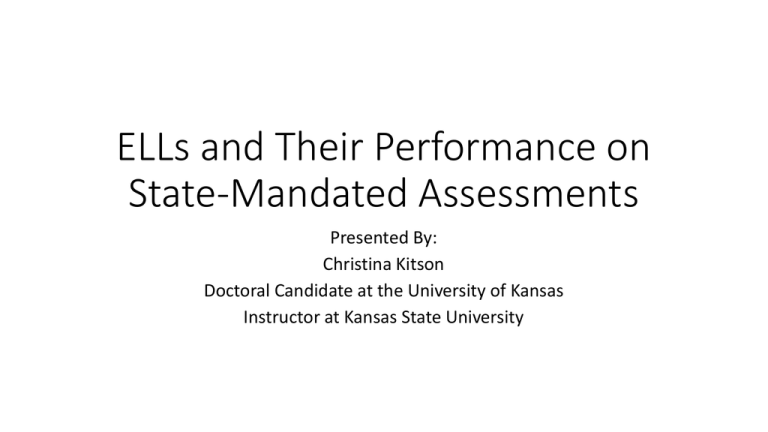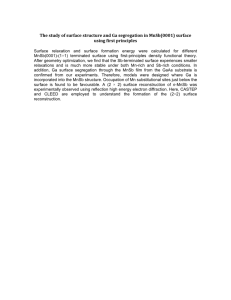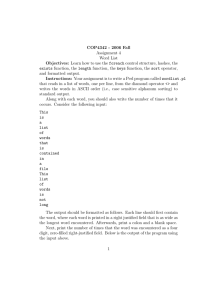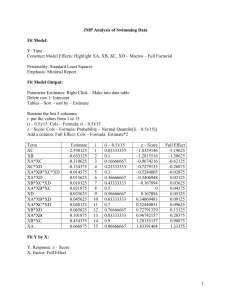ELLs and Their Performance on State-Mandated Assessments
advertisement

ELLs and Their Performance on State-Mandated Assessments Presented By: Christina Kitson Doctoral Candidate at the University of Kansas Instructor at Kansas State University Growing Population • There is a general consensus in the research that this is the fastest growing group of students in the K-12 system in the United States • Wolf et al., 2008a; Tsang, Katz, & Stack, 2008; Abedi, 2004; Kim & Herman, 2009 • In Kansas- ELLs made up between 7 – 14 % of student population in the 2009-2010 school year. • Kansas experienced a five percent population growth in ELLs in public schools from the school year 2000-2001 to 2009-2010. Equal Opportunity for Education • Education Acts to ensure Equal Opportunity: • Equal Educational Opportunities Act (1974) (PL 93-380) • No Child Left Behind Act (2001) (PL 107-110) • Title I – All students have to perform in terms of accountability and adequate yearly progress • Title III- All ELLs have to show they are making progress in acquiring English Language proficiency • Influential court case• Lau v. Nichols (1974) (414 U.S. 563) • Courts found that ELLs should be treated equally with other students and given the same opportunities to learn, including additional English instruction to facilitate English language acquisition Current Research • Often groups all ELLs into a single sub-group when looking at their content performance • Abedi, & Gandara, 2006; Pitoniak, Young, Martiniello, King, Buteux, & Ginsburgh, 2009; Young, Holtzman, & Steinberg, 2011 Requirements of Language Assessment • All language assessments have to have: • Reading, Writing, Listening, and Speaking sections • Assess the ‘academic language’ of the student • Align with the states language proficiency and state content standards. • Scores are used for: • What services to offer ELLs • Report for school and district accountability Validity of Content Assessments • Wolf, Herman, and Dietel (2010) say, validity is, “the degree to which an assessment system produces accurate information about ELL students’ performance and provides a sound basis for policy decisionmaking”. • If language proficiency influences students’ scores, then the validity of the content assessments is in question for use with ELLs • Quoting from The National Research Council directly Abedi and Gandara say, “if a student is not proficient in the language of the test, her performance is likely to be affected by construct-irrelevant variance.” More on Validity • “Performance on these tests may reflect the English language abilities of ELL students rather than their knowledge of the content material the tests are designed to measure (e.g., mathematics skills, scientific knowledge, etc.)” (Abedi, J., Bailey, A., Butler, F., Castellon-Wellington, M., Leon, S., & Mirocha, J., 2005) • According to Wolf, Herman, and Dietel (2010) even math tests are in a way English language tests for the ELL students, “the language demands of any test may get in the way of ELL students showing what they know and inappropriately constrain their performance” Assumptions of Study • Year to year students will perform similarly on their assessments • Both their content and proficiency assessments which allows for generalizations • That a single state may have implications for other states • The study is looking only at one year in Kansas • Each state has unique tests (or is part of a consortium) • Each state has unique interpretations of test scores • Unique standards, cut scores, and proficiency levels Required Tests • During the first year • All students identified as ELLs take proficiency assessment (within 30 days) • All students take the Math content assessment (3rd grade and up) • Have the option to take the Reading 3rd grade and up as well • After the first year all grade required testing and the proficiency assessment • • • • English Proficiency Assessment Math from 3rd grade to 11th Reading from 3rd grade to 11th Science in grades 4, 7, with two opportunities in 9-11th Data used in current study • KELPA score (proficiency group) • • • • Fluent Advanced Intermediate Beginning • Content test scores (Math, Reading, Science) • Meeting (grouped Exemplary, Exceeds Standard, & Meets Standard) • Not Meeting Standards (grouped Approaches Standard & Academic Warning) • Demographic Variables • Gender; Eligibility for National School Lunch Program; Exceptionality Code; First Language; and Number of Years in the US RQ#1 • What are the relative effects of proficiency level on assessment scores across grade levels? • Methods• Proportions will be displayed showing how students performed on each content assessment based on grade level. Math • Look for patterns in the next few charts… Patterns? • What did you notice? • I noticed… • • • • Beginning students did the worst as a group through all grades As the grade went up the scores tended to go down across all proficiencies There is a big difference between Fluent and Beginning performance Fluent had the best performance overall, but… • It got worse as the grades went up • Why? • Content gets harder as well… Reading • Again look for patterns in the next few charts… Patterns? • What did you notice? • I noticed… • • • • Beginning students did the worst as a group through all grades As the grade went up the scores tended to go down across all proficiencies There is a big difference between Fluent and Beginning performance Fluent had the best performance overall, but… • It got worse as the grades went up even more so than Math • Why? • Content gets harder and is directly linked to English ability… Science • Here we only have two grades to look at.. Patterns? • What did you notice? • I noticed… • • • • Again as the proficiency went up the students performed better From 4th to 7th grade less Fluent students meet standards There is a big difference between Fluent and Beginning performance Fluent had the best performance overall, but… • It got worse as the grades went up • Why? • Content gets harder What patterns do you see in the scores for 4th and 7th grades? Patterns • The pattern seems pretty obvious • As the grade goes up the number of students Not Meeting Standards also goes up • As proficiency goes up the number of students Meeting Standards also goes up • There is the largest difference between Fluent and Beginning RQ#2 • What role do other demographic variables (such as free and reduced lunch, native language, gender, length of time in the US, or learning disability) play in student achievement on content assessments for English Language Learners? • Methods• Set of multiple linear regression analysis • Dependent Variable- content assessment score • Independent Variable- student proficiency group and then each of the demographic variables First we will look at overall performance • Each instance when a demographic was identified as being significant (Pr > F) of 5% or less was compiled • This was done for each Content Area (Math, Reading, & Science) • All grades were grouped together by Content Area • The Over-all Predictor Quality was described using this information Predictor Quality Blue = High (100-70) Grey = Low (29-1) Orange = Medium (69-30) Pink = None Type III SS with (Pr > F) of less than 5% Demographic Math % all Reading % Names grades all grades One Way Relationships except 78% 67% totalcat 78% 67% years 89% 22% lunch 78% 67% lang 78% 67% gender 44% 44% Science % all grades Total % Over-all Predictor of all Quality 100% 80% 100% 60% 60% 100% Predictor Quality Blue = High (100-70) Grey = Low (29-1) Orange = Medium (69-30) Pink = None 81% 75% 70% 68% 68% 63% High High High Medium Medium Medium Type III SS with (Pr > F) of less than 5% Demographic Math % all Reading % Names grades all grades Two Way Relationships totalcat*except 56% 67% lang*years 56% 0% gender*except 11% 22% totalcat*lang 11% 33% lang*gender 22% 22% totalcat*lunch 22% 11% years*except 11% 22% totalcat*gender 0% 0% lunch*gender 0% 11% lunch*lang 22% 0% lunch*years 22% 0% lunch*except 0% 0% gender*years 0% 0% totalcat*years 0% 0% lang*except 0% 0% Science % all grades 80% 40% 60% 20% 20% 20% 20% 40% 20% 0% 0% 20% 20% 0% 0% Total % Over-all Predictor of all Quality 67% 32% 31% 21% 21% 18% 18% 13% 10% 7% 7% 7% 7% 0% 0% Medium Medium Medium Low Low Low Low Low Low Low Low Low Low None None Predictor Quality Blue = High (100-70) Orange = Medium (69-30) Grey = Low (29-1) Pink = None Predictability • The best single demographics for predictability are (above 70%): • Exceptionality (Learning Disabled, Gifted, None, or Other) • Total Proficiency Category • Number of Years in the U.S. • There are no best categories for the two-way the highest is: • Total Proficiency Category * Exceptionality (67% over-all) • Let’s look at the breakdown of the demographics Exceptionality Math Estimate Pr > F Grade 3 Grade 4 Grade 5 Grade 6 Grade 7 Grade 8 Grade 9 Grade 10 Grade 11 -2.8574 -4.1481 -6.2981 -5.1562 -4.7721 -3.2436 2.0296 R-Score 31% 0.0053 33% 0.0003 30% <0.0001 34% 0.0014 30% 0.0141 26% 19% 0.0268 29% 0.0002 19% Reading Science Estimate Pr > F R-Score Estimate Pr > F R-Score -5.8765 <.0001 41% N/A -0.2374 <.0001 33% -3.5882 0.0036 44% -4.8852 <0.0001 44% N/A -4.8830 0.0002 45% N/A 49% -4.8295 0.0010 37% -8.6270 <.0001 46% N/A 12.0184 0.0336 63% -13.4391 0.0016 36% -16.9082 <.0001 39% -4.6795 0.0075 16% 39% -3.4417 0.0379 21% • Universally applicable • Mostly Negative relationships • Very significant (Pr > F less than 1%) Total Proficency Category Math Reading Science Estimate Pr > F R-Score Estimate Pr > F R-Score Estimate Pr > F R-Score Grade 3 9.2702 <0.0001 31% 6.6749 <0.0001 41% N/A Grade 4 5.9462 <0.0001 33% 0.6238 <.0001 33% 5.1944 0.0003 44% Grade 5 4.4226 0.0011 30% 4.8709 0.0215 44% N/A Grade 6 34% 45% N/A Grade 7 5.1981 0.0083 30% 13.5756 <0.0001 49% 4.7578 0.0039 37% Grade 8 4.5991 0.0228 26% 5.5644 0.0007 46% N/A Grade 9 13.9182 <.0001 19% 63% 36% Grade 10 10.6517 <.0001 29% 39% 7.1134 <.0001 16% Grade 11 19% 10.9264 <.0001 39% 8.7680 0.0008 21% • Universally applicable • Entirely positive relationships • Very significant (Pr > F less than 1%) Number of Years in the U.S. Math Estimate Pr > F Grade 3 Grade 4 Grade 5 Grade 6 Grade 7 Grade 8 Grade 9 Grade 10 Grade 11 0.1143 -0.6321 -1.2020 -2.5474 -2.0645 -0.3835 -3.1872 0.1311 R-Score 31% 0.0111 33% 0.0298 30% 0.0049 34% <0.0001 30% <.0001 26% <.0001 19% <.0001 29% <.0001 19% Reading Estimate Pr > F 0.4743 0.0778 R-Score 41% 33% 44% 45% 49% 0.0026 46% 63% 0.0093 39% 39% Science Estimate Pr > F 0.4122 -1.5095 0.2670 0.0790 -1.3635 R-Score N/A 0.0004 44% N/A N/A <0.0001 37% N/A <.0001 36% 0.0036 16% <.0001 21% • More applicable for Math and Science (not much for Reading) • Mostly Negative relationships • Very significant (Pr > F less than 1%) Math & Science Free and Reduced Lunch Program Eligibility Math Estimate Pr > F Grade 3 Grade 4 Grade 5 Grade 6 Grade 7 Grade 8 Grade 9 Grade 10 Grade 11 -1.5662 -10.9333 -2.6347 -2.6553 -66.1633 -5.6149 -14.1405 R-Score 31% 33% 0.0209 30% 0.0010 34% 0.0029 30% 0.0129 26% 0.0356 19% <.0001 29% 0.0084 19% Reading Science Estimate Pr > F R-Score Estimate Pr > F R-Score -2.9557 <0.0001 41% N/A 33% -3.0859 <.0001 44% 44% N/A -9.4489 0.0028 45% N/A -2.3144 0.0010 49% -3.8119 <0.0001 37% -2.8237 0.0014 46% N/A 63% 36% -4.0528 0.0004 39% -14.3022 0.0158 16% -6.2318 <.0001 39% 21% • Most applicable to Reading then Math; Not very for Science • Entirely Negative relationships • Very significant (Pr > F less than 1%) Reading & somewhat Math First Language Math Reading Science Estimate Pr > F R-Score Estimate Pr > F R-Score Estimate Pr > F R-Score Grade 3 -0.2738 0.0052 31% -0.5036 0.0002 41% N/A Grade 4 -0.2785 0.0080 33% 6.3095 0.0407 33% -0.5619 <.0001 44% Grade 5 -0.5339 <0.0001 30% -1.1727 0.0104 44% N/A Grade 6 -0.7167 0.0002 34% -1.3341 0.0034 45% N/A Grade 7 -1.1397 <0.0001 30% 49% -0.8398 <0.0001 37% Grade 8 -1.1974 <.0001 26% -0.3755 0.0095 46% N/A Grade 9 19% 63% 36% Grade 10 29% 39% 16% Grade 11 -1.4506 0.0148 19% 0.4002 0.0240 39% 1.0395 0.0167 21% • Most significant in Math then Reading; Not very in Science • Mostly Negative relationships • Very significant (Pr > F less than 1%) Math Gender Math Reading Science Estimate Pr > F R-Score Estimate Pr > F R-Score Estimate Pr > F R-Score Grade 3 2.0035 <0.0001 31% -5.9785 0.0132 41% N/A Grade 4 2.5902 <0.0001 33% -4.0051 0.0020 33% 9.1613 0.0002 44% Grade 5 30% 44% N/A Grade 6 1.2272 0.0137 34% 45% N/A Grade 7 30% 1.2015 0.0068 49% -6.6878 0.0068 37% Grade 8 26% 46% N/A Grade 9 19% 63% 36% Grade 10 29% -15.5454 0.0008 39% 4.4694 <.0001 16% Grade 11 11.1023 0.0052 19% 39% 16.9798 0.0002 21% • Negative and positive relationships • Very significant (Pr > F less than 1%) when it appears usually significant (or just above 1%) Exceptionality * Total Category Math Estimate Pr > F Grade 3 Grade 4 Grade 5 Grade 6 Grade 7 Grade 8 Grade 9 Grade 10 Grade 11 1.2357 1.6877 2.5020 2.0268 2.1122 R-Score 31% 0.0101 33% 0.0003 30% 0.0001 34% 0.0026 30% 0.0025 26% 19% 29% 19% Reading Science Estimate Pr > F R-Score Estimate Pr > F R-Score 1.3224 0.0041 41% N/A 1.3367 0.0011 33% 1.4638 0.0026 44% 1.3121 0.0017 44% N/A 1.5207 0.0078 45% N/A 49% 1.4481 0.0092 37% 2.9604 <.0001 46% N/A 63% 4.2674 0.0013 36% 3.8265 0.0001 39% 16% 39% 2.0398 0.0004 21% • Universally applicable • Entirely Positive relationships • Very significant (Pr > F less than 1%) Exceptionality * Gender Math Estimate Pr > F Grade 3 Grade 4 Grade 5 Grade 6 Grade 7 Grade 8 Grade 9 Grade 10 Grade 11 4.0937 R-Score 31% 33% 30% 34% 30% 26% 19% 0.0258 29% 19% Reading Estimate Pr > F -1.9988 5.0127 • Not very Universally applicable • Positive and Negative relationships • Overall not a very good predictor R-Score 41% 0.0038 33% 44% 45% 49% 46% 63% 0.0017 39% 39% Science Estimate Pr > F -2.0014 1.6292 -2.1726 R-Score N/A 0.0149 44% N/A N/A 0.0348 37% N/A 36% 16% 0.0339 21% Exceptionality * Number of Years in the U.S. Math Estimate Pr > F Grade 3 Grade 4 Grade 5 Grade 6 Grade 7 Grade 8 Grade 9 Grade 10 Grade 11 -0.1381 R-Score 31% 33% 30% 34% 30% 0.0372 26% 19% 29% 19% Reading Estimate Pr > F -0.1546 0.1155 • Not very Universally applicable • Mostly Negative relationships • Overall not a very good predictor R-Score 41% 33% 44% 45% 49% 0.0040 46% 63% 39% 0.0294 39% Science Estimate Pr > F -0.1250 R-Score N/A 0.0012 44% N/A N/A 37% N/A 36% 16% 21% Exceptionality * Free and Reduced Lunch Eligibility Math Estimate Pr > F Grade 3 Grade 4 Grade 5 Grade 6 Grade 7 Grade 8 Grade 9 Grade 10 Grade 11 R-Score 31% 33% 30% 34% 30% 26% 19% 29% 19% • Not a good predictor Reading Estimate Pr > F R-Score 41% 33% 44% 45% 49% 46% 63% 39% 39% Science Estimate Pr > F 4.6486 R-Score N/A 44% N/A N/A 37% N/A 36% 0.0223 16% 21% Exceptionality * Language Math Estimate Pr > F Grade 3 Grade 4 Grade 5 Grade 6 Grade 7 Grade 8 Grade 9 Grade 10 Grade 11 R-Score 31% 33% 30% 34% 30% 26% 19% 29% 19% Reading Estimate Pr > F • No instances of predictability R-Score 41% 33% 44% 45% 49% 46% 63% 39% 39% Science Estimate Pr > F R-Score N/A 44% N/A N/A 37% N/A 36% 16% 21% Findings • Beginning students uniformly perform poorly on content assessments • Fluent students perform best on content assessments • As the grade goes up the percent of students meeting standards goes down • There are a few good predictors for score • • • • Exceptionality code (Learning Disabled, Gifted, N/A, or Other) English Proficiency (Beginning, Intermediate, Advanced, and Fluent) Number of years in the U.S. Exceptionality and English Proficiency Questions? Thank you for coming! Christina Kitson clkit96@gmail.com




